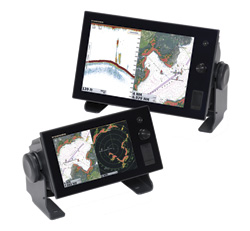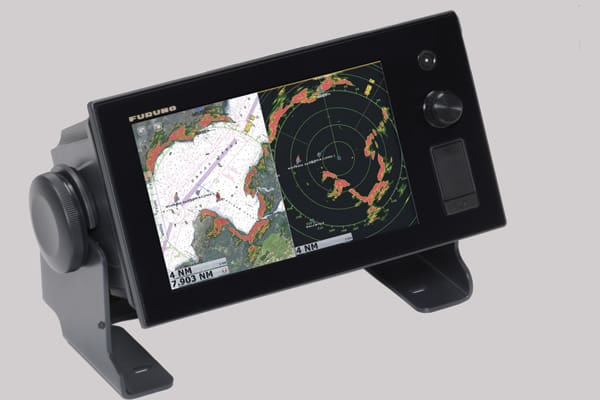 |
|
With these new Furuno multi-function displays, you’re supposed to look and touch. The TZT9, left, and the TZT14 can be controlled using finger gestures similar to a smartphone or tablet. Courtesy Furuno |
Multitouch, as any smartphone owner knows, is the name given to distinctive finger gestures used to control touch-screen devices such as an iPhone, Android phone, iPad or other tablet. Multitouch involves a deft series of taps, swipes, pinching to zoom, etc. This capability has virtually done away with knobs and buttons. It makes sense that this interface method would be popular in the marine world as well. At the Miami International Boat Show in February, Furuno unveiled its version of multitouch called NavNet TZtouch.
The flagship devices for TZtouch are the TZT14 and TZT9 multi-function displays (MFDs). The multitouch capabilities include pinch to zoom, two-finger course rotation and other multi- and single-touch gestures that make these two Furuno MFDs operate like smartphones. You can also customize the interface by assigning certain finger gestures to specific commands.
One of the potential drawbacks to touch screens on board a boat is the stability of the platform. Boats, after all, will move around in the waves, potentially making it difficult to perform multitouch gestures. To allow users to control the MFDs, Furuno has included its RotoKey rotary knob. But the rotary knob is the only control knob on the unit.
With their multitouch capabilities and the speedy MaxSea TimeZero graphics engine, a powerful processor was needed to drive the TZT14 and TZT9 units. Furuno opted for an Intel chip code-named Sandy Bridge. This powerful CPU isn’t a limited processor used for simple, single-purpose electronic devices, this is a full bore-PC processor found in numerous current laptop models. In fact, the Sandy Bridge product was named “Best PC Processor” for 2011 by The Linley Group, publishers of the trade newsletter Microprocessor Report.
An area of growing interest for many voyagers is the ability to use their smartphone or tablet to view data from their navigational network. These new Furuno MFDs use Wi-Fi to allow users not only to see data from their NavNet network using the NavNet Viewer App, but also to control the MFD units from either a smartphone or a tablet using the NavNet Remote App.
For charts, the TZT14 and TZT9 come equipped with free NOAA raster and vector charts and bathymetric data for the whole U.S. coastline. C-Map by Jeppesen vector charts for North America that have been converted to MapMedia format are also provided. All these charts are preloaded onto a 64-GB SD card that comes with each TZT unit.
Of course, with all this processing power and with their bright 14.1-inch and 9-inch screens, these units do need power. The TZT9 requires 51 watts and the TZT14 needs 71 watts. Prices for these MFDs are $5,695 for the TZT9 and $7,695 for the TZT14.
Navionics fresh data
Crowd-sourcing, the process of distributing a task to anyone in the public who wants to work on it, hasn’t been something most people associate with charts — either paper or electronic. We tend to think charts are produced by careful, deliberate hydrographic offices. Now the electronic chart company Navionics is expanding a crowd-sourcing program it started with its mobile chart apps last year. It’s called user-generated content and it means chart users can add their own changes to Navionics electronic charts. Navionics includes this user-generated content in their daily chart updates that users can download to their chart cards. Navionics calls the combination of user content and the company’s own chart improvements its “Freshest Data” program. The goal is to get chart updates into users hands as quickly as possible. According to Navionics, the elapsed time between when NOAA becomes aware of the need for a change to a chart and when that change appears on the chart is two to five years. With user-generated content, the ability to add an edit shrinks to just a few minutes.
In the roughly one year that Navionics has allowed for user-generated content, the company has processed more than 200,000 edits — with about 100,000 coming from Europe, more than 60,000 coming from the U.S. and Canada, and 30,000 from Australia and New Zealand.
“In the past year, Navionics Freshest Data and user-generated content has revolutionized cartography by providing on-the-fly updates and ensuring the most accurate data possible,” said Don Black, global vice president of sales and marketing, “all at a rate that greatly exceeds the world’s leading hydrographic offices.”
The Navionics user-generated content can only be used with Navionics Gold and Platinum+ charts.
The cleanest outboard?
Another interesting product at the 2012 Miami International Boat Show were propane-fueled outboards from a company named Lehr Inc., from Los Angeles. Lehr offers 2.5-hp and 5-hp propane powered engines voyagers can use on their tenders and dinghies. Lehr makes the point that, environmentally speaking, propane is a superior fuel to gasoline. It costs less, doesn’t spill and reduces particulate and hydrocarbon emissions. Another nice advantage for anyone who has ever tried to get an outboard started, these engines have no choke and require no priming.
The Lehr outboards can be run using either a 16.4-oz camping bottle size tank that screws into a fitting on the back of the engine, or a five gallon remote tank that connects to the engine via a fuel hose.

